Experimental Studies on Fretting Wear Behavior of PVDF Piezoelectric Thin Films
Abstract
1. Introduction
2. Materials and Experimental Details
2.1. Materials
2.2. Preparation of Test Specimens
2.3. Fretting Wear Test
2.4. Characterizations
- Scan the surface with a white light interference profilometer and obtain the information of the wear scar.
- Select the area outside the wear scar as the reference area. The average height of all points in the reference area is the height of the datum reference.
- Then, the software of the 3D optical profiler will compute the wear volume value for all the points under datum reference.
3. Results and Discussion
3.1. Curves of Friction
3.2. Surface Wear Topography
- The plastic deformation causes surface wrinkles when D = ±20 μm, and the increase in displacement amplitude (D = ±40 μm) makes the surface wrinkles disappear
- The wear depth increases with the increase in the displacement amplitude
3.3. Wear Volume and Specific Wear Rate
3.4. Fretting Wear under the Applied Voltage
4. Conclusions
- The friction coefficient of the PVDF thin films shows an increasing trend from 0.07 to 0.144 with the increase in displacement amplitude, and shows a decreasing trend from 0.115 to 0.081 with the increase in applied normal force under the setting condition.
- The increase in displacement amplitude leads to the change of the contact region from the partial slip region to the gross slip region. However, the increase in normal force results in the change of the contact region from the gross slip region to the mixed region.
- The plastic deformation and creep cause surface wrinkles, and the increase in displacement amplitude will reduce or even eliminate the surface wrinkles.
- The wrinkles in the mixed region are more obvious than in the partial/gross slip regions.
- With the increase in the displacement amplitude (from ±5 μm to ±40 μm) and normal force (from 15 N to 50 N), the wear volume increases, while the specific wear rate decreases first and then increases.
- The fretting wear mechanism of the PVDF thin film is complex and can be considered as a self-organized process, containing a variety of interrelated mechanisms of friction and deformation
- With the increase in voltage, both wear volume and specific wear rate first increase and then decrease, and reach the minimum value at Vc = 3 V.
- To consider different piezoelectric thin films (PVF, PZT, ZnS, ZnO, etc.) and compare their fretting wear behavior;
- To discuss the effect of the external applied voltage and prestress;
- To consider other fretting modes, such as rotational fretting, radial fretting, torsional fretting, and composite fretting;
- To carry out the finite element simulation on the fretting wear of piezoelectric thin films and compare with the experimental results.
Author Contributions
Funding
Institutional Review Board Statement
Informed Consent Statement
Data Availability Statement
Conflicts of Interest
References
- Han, B.G.; Yu, X.; Ou, J.P. Self-Sensing Concrete in Smart Structures, 1st ed.; Butterworth-Heinemann: Oxford, UK, 2014; pp. 361–376. [Google Scholar]
- Khan, A.; Abas, Z.; Soo Kim, H.; Oh, I.K. Piezoelectric thin films: An integrated review of transducers and energy harvesting. Smart Mater. Struct. 2016, 25, 053002. [Google Scholar] [CrossRef]
- Ueberschlag, P. PVDF piezoelectric polymer. Sens. Rev. 2001, 21, 118–126. [Google Scholar] [CrossRef]
- Rajala, S.; Lekkala, J. Film-type sensor materials PVDF and EMF in measurement of cardiorespiratory signals—A review. IEEE Sens. J. 2012, 12, 439–446. [Google Scholar] [CrossRef]
- Chang, C.; Tran, V.H.; Wang, J.; Fuh, Y.K.; Lin, L. Direct-write piezoelectric polymeric nanogenerator with high energy conversion efficiency. Nano Lett. 2010, 10, 726–731. [Google Scholar] [CrossRef] [PubMed]
- Yan, J.; Liu, M.; Young, G.J.; Kang, W.M.; Li, L.; Zhao, Y.X.; Deng, N.P.; Cheng, B.W.; Yang, G. Performance enhancements in poly(vinylidene fluoride)-based piezoelectric nanogenerators for efficient energy harvesting. Nano Energy 2019, 56, 662–692. [Google Scholar] [CrossRef]
- Oshiki, M.; Fukada, E. Inverse piezoelectric effect and electrostrictive effect in polarized poly (vinylidene fluoride) films. J. Mater. Sci. 1975, 10, 1–6. [Google Scholar] [CrossRef]
- Pérez, P.; Král, M.; Bleuler, H. Study of polyvinylidene fluoride (PVDF) based bimorph actuators for laser scanning actuation at kHz frequency range. Sens. Actuators A 2012, 183, 84–94. [Google Scholar] [CrossRef]
- Xu, H.S.; Cheng, Z.Y.; Olson, D.; Mai, T.; Zhang, Q.M.; Kavarnos, G. Ferroelectric and electromechanical properties of poly(vinylidene-fluoride-trifluoroethylene-chlorotrifluo -roethylene) terpolymer. Appl. Phys. Lett. 2001, 78, 2360–2362. [Google Scholar] [CrossRef]
- Tamjidi, N.; Sato, K.; Sakurai, J.; Hata, S. PVDF Actuator for high-frequency fatigue test of thin-film metals. IEEJ Trans. Electr. Electron. Eng. 2013, 8, 199–205. [Google Scholar] [CrossRef]
- Chen, L.; Di, C.; Chen, X.; Li, Z.; Luo, J. Friction properties of biological functional materials: PVDF membranes. Bioengineered 2016, 8, 78–84. [Google Scholar] [CrossRef][Green Version]
- Waterhouse, R.B. Fretting wear. Wear 1984, 100, 107–118. [Google Scholar] [CrossRef]
- Berthier, Y.; Vincent, L.; Godet, M. Fretting fatigue and fretting wear. Tribol. Int. 1989, 22, 235–242. [Google Scholar] [CrossRef]
- Fu, Y.Q.; Batchelor, A.W.; Wang, Y.; Khor, K.A. Fretting wear behaviors of thermal sprayed hydroxyapatite (ha) coating under unlubricated conditions. Wear 1998, 217, 132–139. [Google Scholar] [CrossRef]
- Chen, L.; Xia, X.T.; Qiu, M. Analysis and control of fretting wear for blade bearing in wind turbine. Appl. Mech. Mater. 2010, 26, 167–170. [Google Scholar] [CrossRef]
- Diomidis, N.; Mischler, S. Third body effects on friction and wear during fretting of steel contacts. Tribol. Int. 2010, 44, 1452–1460. [Google Scholar] [CrossRef]
- Zhu, M.H.; Zhou, Z.R. On the mechanisms of various fretting wear modes. Tribol. Int. 2011, 44, 1378–1388. [Google Scholar] [CrossRef]
- Long, M.; Rack, H.J. Titanium alloys in total joint replacement--a materials science perspective. Biomaterials 1998, 19, 1621–1639. [Google Scholar] [CrossRef]
- Fan, B.; Li, B.; Feng, S.; Mao, J.H.; Xie, Y.B. Modeling and experimental investigations on the relationship between wear debris concentration and wear rate in lubrication systems. Tribol. Int. 2017, 109, 114–123. [Google Scholar] [CrossRef]
- Söderberg, S.; Vingsbo, O. On fretting maps. Wear 1988, 126, 131–147. [Google Scholar]
- Zhou, Z.R.; Nakazawa, K.; Zhu, M.H.; Maruyama, N.; Kapsa, P.; Vincent, L. Progress in fretting maps. Tribol. Int. 2006, 39, 1068–1073. [Google Scholar] [CrossRef]
- Ding, J.; Leen, S.B.; Mccoll, I.R. The effect of slip regime on fretting wear-induced stress evolution. Int. J. Fatigue 2004, 26, 521–531. [Google Scholar] [CrossRef]
- Wu, Y.P.; Li, Z.Y.; Zhu, S.F.; Lu, L.; Cai, Z.B. Effect of frequency on fretting wear behavior of Ti/TiN multilayer film on depleted uranium. PLoS ONE 2017, 12, e0175084. [Google Scholar] [CrossRef]
- Kirk, A.M.; Shipway, P.H.; Sun, W.; Bennett, C.J. The effect of frequency on both the debris and the development of the tribologically transformed structure during fretting wear of a high strength steel. Wear 2019, 426, 694–703. [Google Scholar] [CrossRef]
- Xu, C.M.; Peng, Y.X.; Zhu, Z.C.; Lu, H.; Chen, G.A.; Wang, D.G.; Peng, X.; Wang, S.J. Fretting friction and wear of steel wires in tension-torsion and helical contact form. Wear 2019, 432, 202946. [Google Scholar] [CrossRef]
- Ming, H.L.; Liu, X.C.; Zhang, Z.M.; Wang, J.Q.; Han, E.H. Effect of normal force on the fretting wear behavior of Inconel 690 TT against 304 stainless steel in simulated secondary water of pressurized water reactor. Tribol. Int. 2018, 126, 133–143. [Google Scholar] [CrossRef]
- Endo, H.; Marui, E. Studies on fretting wear (combinations of various ceramics spheres and carbon steel plates). Wear 2004, 257, 80–88. [Google Scholar] [CrossRef]
- Jin, O.; Mall, S. Effects of independent pad displacement on fretting fatigue behavior of Ti-6Al-4V. Wear 2002, 253, 585–596. [Google Scholar] [CrossRef]
- Mi, X.; Xie, H.; Tang, P.; Cai, Z.B.; Peng, J.F.; Zhu, M.H. Effect of environmental condition on the chemical behavior of 690 alloy during fretting wear. Tribol. Int. 2020, 146, 106202. [Google Scholar] [CrossRef]
- Blades, L.; Hills, D.; Nowell, D.; Evans, K.E.; Smith, C. An exploration of debris types and their influence on wear rates in fretting. Wear 2020, 450, 203252. [Google Scholar] [CrossRef]
- Li, W.; Li, N.; Zheng, Y.; Yuan, G. Fretting properties of biodegradable Mg-Nd-Zn-Zr alloy in air and in Hank’s solution. Sci. Rep. 2016, 6, 35803. [Google Scholar] [CrossRef] [PubMed]
- Marc, E.; Fouvry, S.; Graton, O.; Phalippou, C.; Maitournam, H. Fretting wear of a nitrided 316L/304L contact subject to in-phase normal force fluctuation in dry and lithium-boron solution: An RP-friction energy wear approach. Wear 2017, 376, 690–704. [Google Scholar] [CrossRef]
- Pereira, K.; Yue, T.; Wahab, M.A. Multiscale analysis of the effect of roughness on fretting wear. Tribol. Int. 2017, 110, 222–231. [Google Scholar] [CrossRef]
- Guo, X.L.; Lai, P.; Tang, L.C.; Chen, K.; Zhang, L.F. Time-dependent wear behavior of alloy 690 tubes fretted against 405 stainless steel in high-temperature argon and water. Wear 2018, 414, 194–201. [Google Scholar] [CrossRef]
- Borrell, A.; Gil, L.; Presenda, A.; Salvador, M.D.; Vleugels, J.; Moreno, R. Influence of relative humidity and low temperature hydrothermal degradation on fretting wear of Y-TZP dental ceramics. Wear 2019, 428, 1–9. [Google Scholar] [CrossRef]
- Surmenev, R.A.; Orlova, T.; Chernozem, R.V.; Ivanova, A.A.; Bartasyte, A.; Mathur, S.; Surmeneva, M.A. Hybrid lead-free polymer-based nanocomposites with improved piezoelectric response for biomedical energy-harvesting applications: A review. Nano Energy 2019, 62, 475–506. [Google Scholar] [CrossRef]
- Fan, B.H.; Zhou, M.Y.; Zhang, C.; He, D.L.; Bai, J.B. Polymer-based materials for achieving high energy density film capacitors. Prog. Polym. Sci. 2019, 97, 101143. [Google Scholar] [CrossRef]
- Anupama, G.; Dipak, R.; Pralay, M. Mechanical and wear behaviour of poly(vinylidene fluoride) clay nanocomposite. J. Mater. Res. Technol. 2019, 8, 5874–5881. [Google Scholar]
- Higham, P.A.; Stott, F.H.; Bethune, B. The influence of polymer composition on the wear of the metal surface during fretting of steel on polymer. Wear 1978, 47, 71–80. [Google Scholar] [CrossRef]
- Su, J.; Ke, L.L.; Wang, Y.S. Two-dimensional fretting contact analysis of piezoelectric materials. Int. J. Solids. Struct. 2015, 73–74, 41–54. [Google Scholar] [CrossRef]
- Su, J.; Ke, L.L.; Wang, Y.S. Axisymmetric partial slip contact of a functionally graded piezoelectric coating under a conducting punch. J. Intel. Mater. Syst. Struct. 2017, 28, 1925–1940. [Google Scholar] [CrossRef]
- Zhou, Y.T.; Lee, K.Y. Investigation of frictional sliding contact problems of triangular and cylindrical punches on monoclinic piezoelectric materials. Mech. Mater. 2014, 69, 237–250. [Google Scholar] [CrossRef]
- Chung, K.H.; Lee, Y.H.; Kim, Y.T.; Kim, D.E.; Yoo, J.; Hong, S. Nano-tribological characteristics of PZT thin film investigated by atomic force microscopy. Surf. Coat. Technol. 2007, 201, 7983–7991. [Google Scholar] [CrossRef]
- Fedosov, S.N.; Sergeeva, A.V.; Giacometti, J.A.; Ribeiro, P.A.; Wlochowicz, A. Corona poling of a ferroelectric polymer (pvdf). Proc. SPIE Int. Soc. Opt. Eng. 1999, 4017, 53–58. [Google Scholar]
- Iglesias Montes, M.L.; Cyras, V.P.; Manfredi, L.B.; Pettarín, V.; Fasce, L.A. As the method shown in Fracture evaluation of plasticized polylactic acid / poly (3-hydroxybutyrate) blends for commodities replacement in packaging applications. Polym. Test. 2020, 84, 106375. [Google Scholar] [CrossRef]
- Ma, L.F.; Eom, K.; Geringer, J.; Jun, T.S.; Kim, K. Literature review on fretting wear and contact mechanics of tribological coatings. Coatings 2019, 9, 501. [Google Scholar] [CrossRef]
- Lhymn, C. Effect of normal load on the specific wear rate of fibrous composites. Wear 1987, 120, 1–27. [Google Scholar] [CrossRef]
- Zhou, Z.R.; Vincent, L. Mixed fretting regime. Wear 1995, 181, 531–536. [Google Scholar] [CrossRef]
- Kim, K.; Korsunsky, A.M. Dissipated energy and fretting damage in CoCrAlY-MoS2 coatings. Tribol. Int. 2010, 43, 676–684. [Google Scholar] [CrossRef]
- Li, X.; Dong, M.; Jiang, D.Y.; Li, S.F.; Shang, Y. The effect of surface roughness on normal restitution coefficient, adhesion force and friction coefficient of the particle-wall collision. Powder Technol. 2020, 362, 17–25. [Google Scholar] [CrossRef]
- Dzyura, V.O.; Maruschak, P.O.; Zakiev, I.M.; Sorochak, A.P. Analysis of inner surface roughness parameters of load-carrying and support elements of mechanical systems. Int. J. Eng. Trans. B 2017, 30, 1170–1175. [Google Scholar]
- Wang, Q.F.; Wang, Y.X.; Wang, H.L.; Fan, N.; Yan, F.Y. Experimental investigation on tribological behavior of several polymer materials under reciprocating sliding and fretting wear conditions. Tribo. Int. 2016, 104, 73–82. [Google Scholar] [CrossRef]
- Maruschak, P.O.; Panin, S.V.; Zakiev, I.M.; Poltaranin, M.A.; Sotnikov, A.L. Scale levels of damage to the raceway of a spherical roller bearing. Eng. Fail. Anal. 2016, 59, 69–78. [Google Scholar] [CrossRef]
- Soin, N.; Anand, S.C.; Shah, T.H. Energy Harvesting and Storage Textiles, 2nd ed.; University of Bolton: Bolton, UK, 2016; pp. 357–396. [Google Scholar]

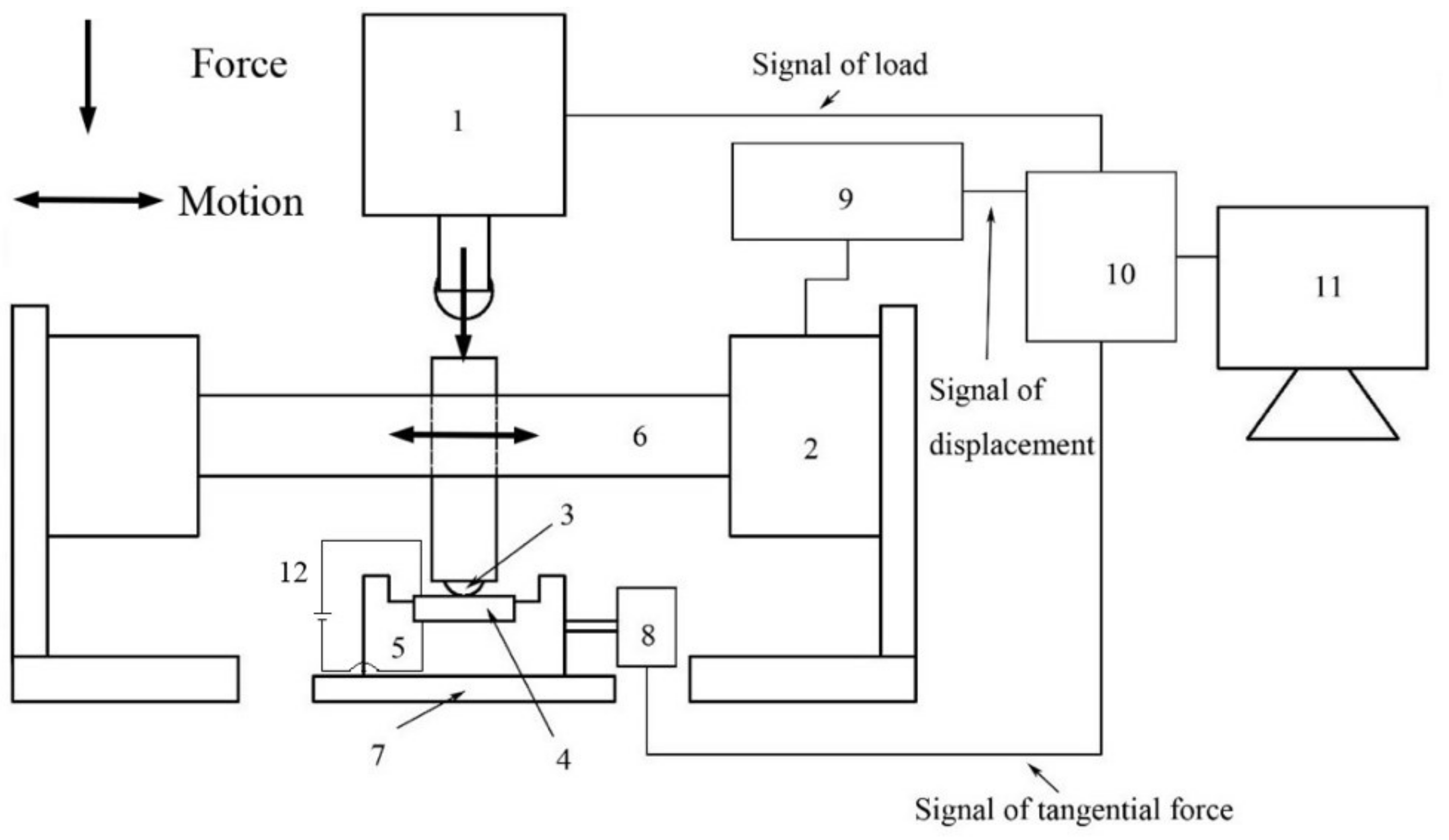
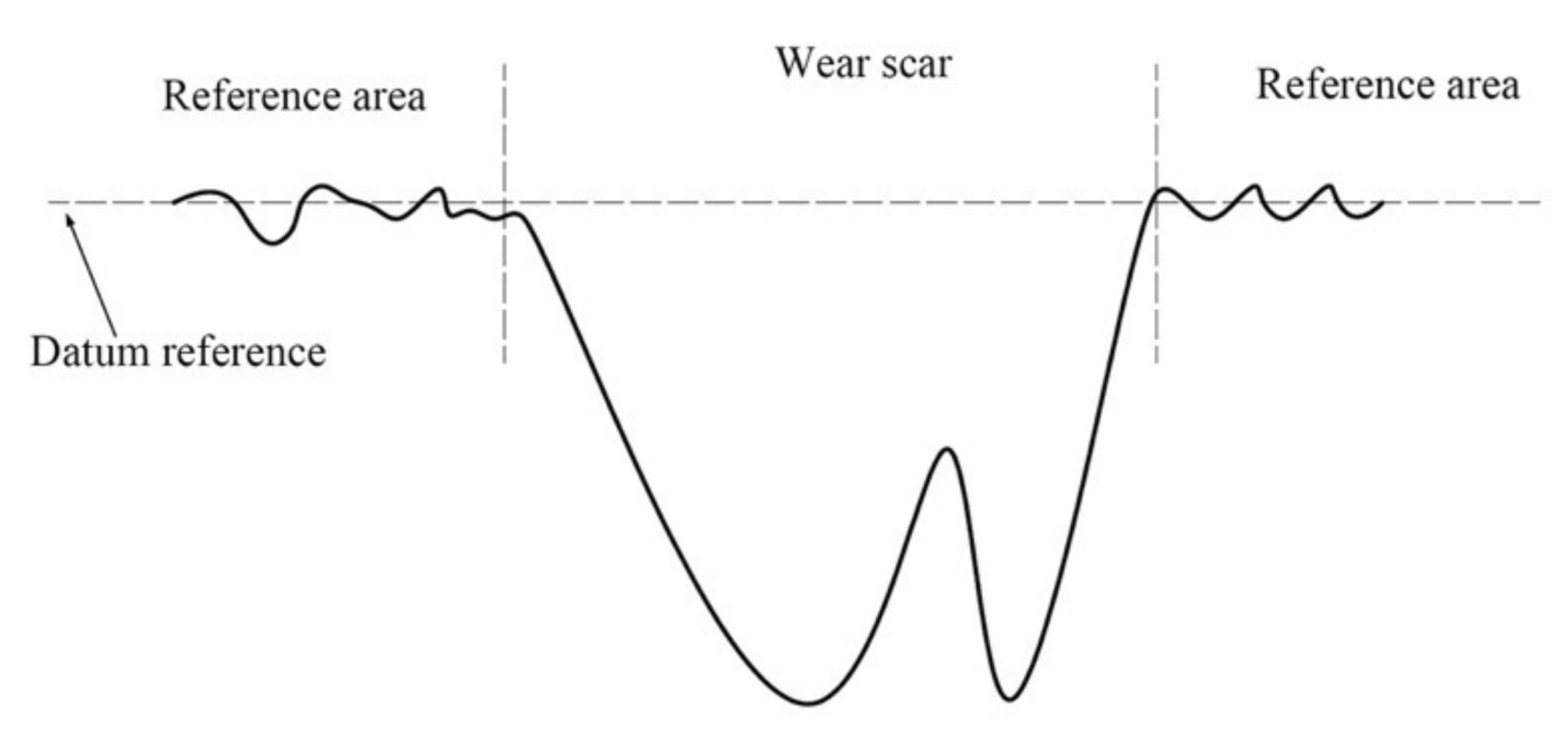
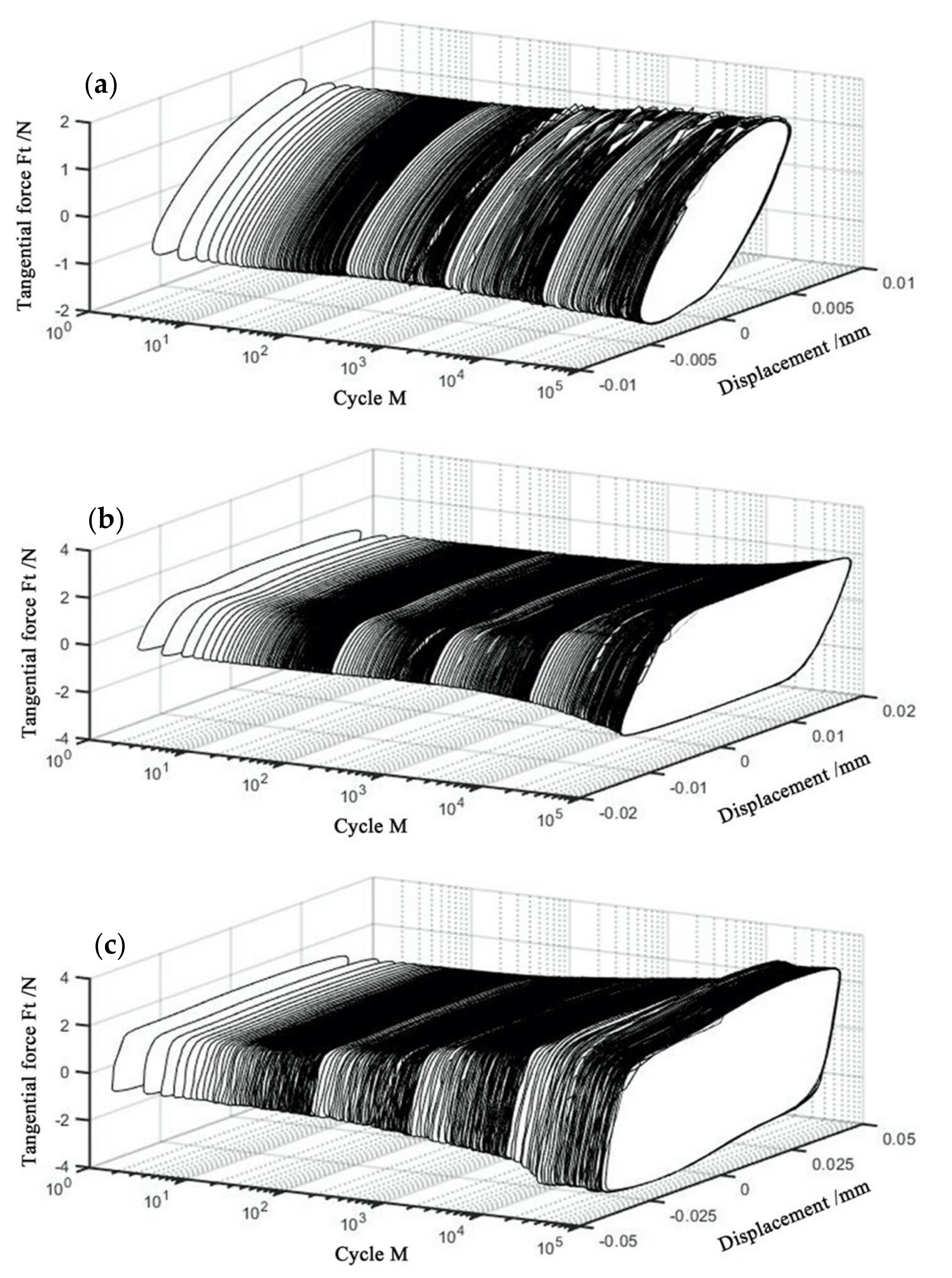
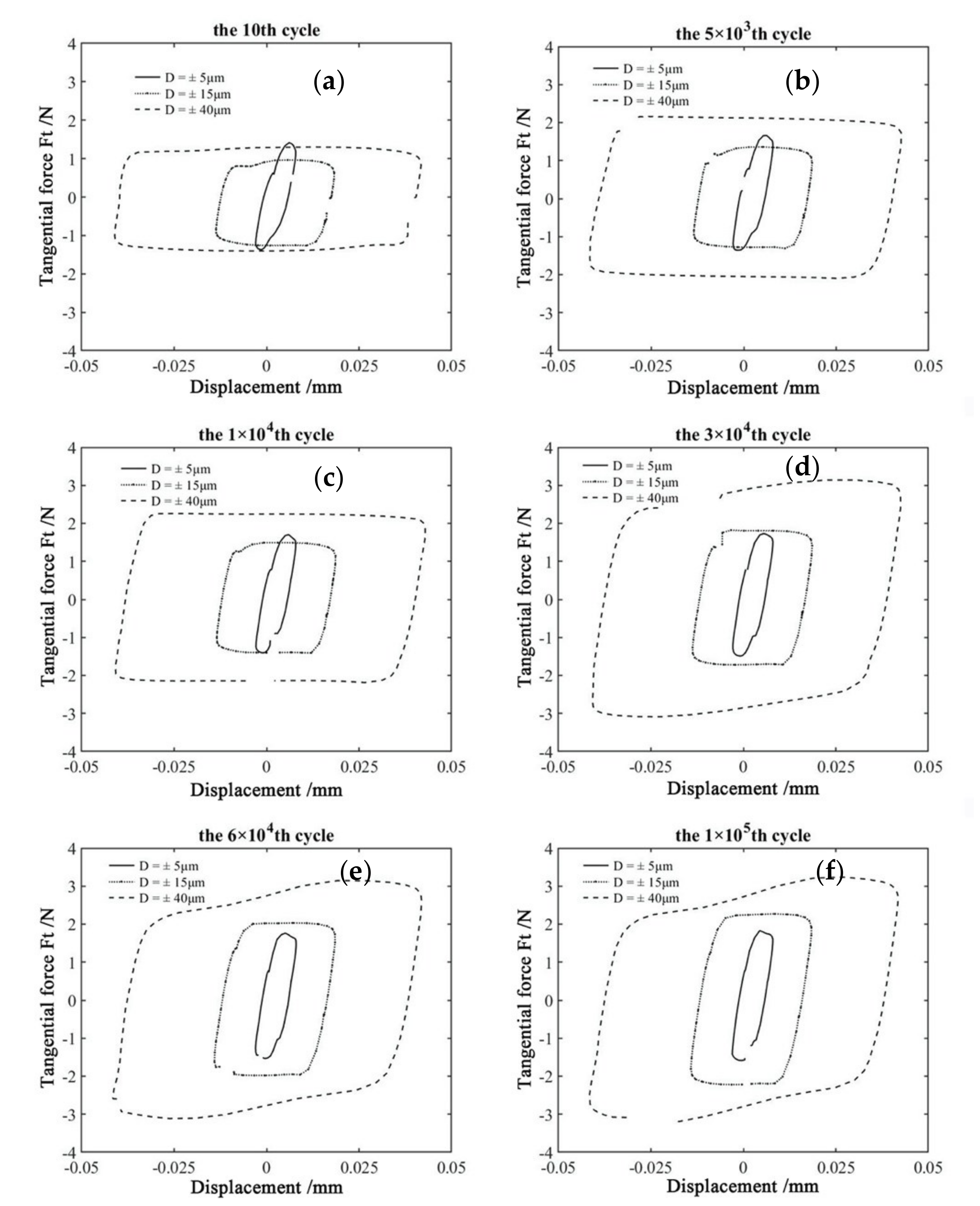
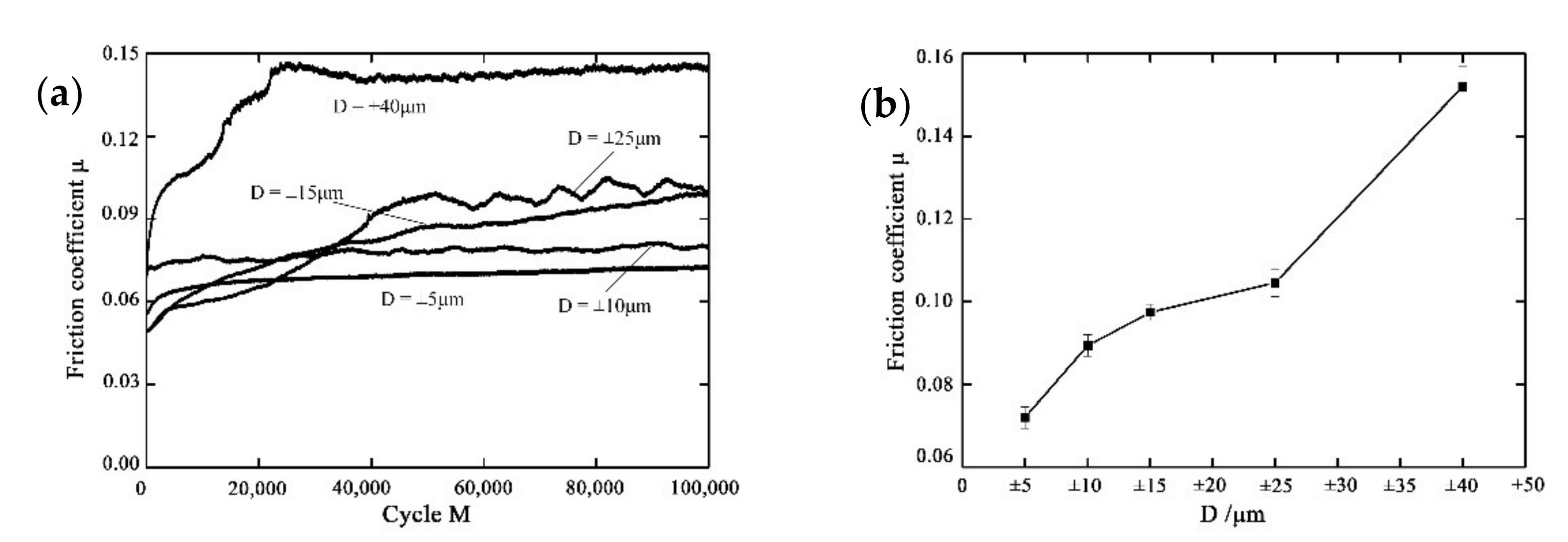

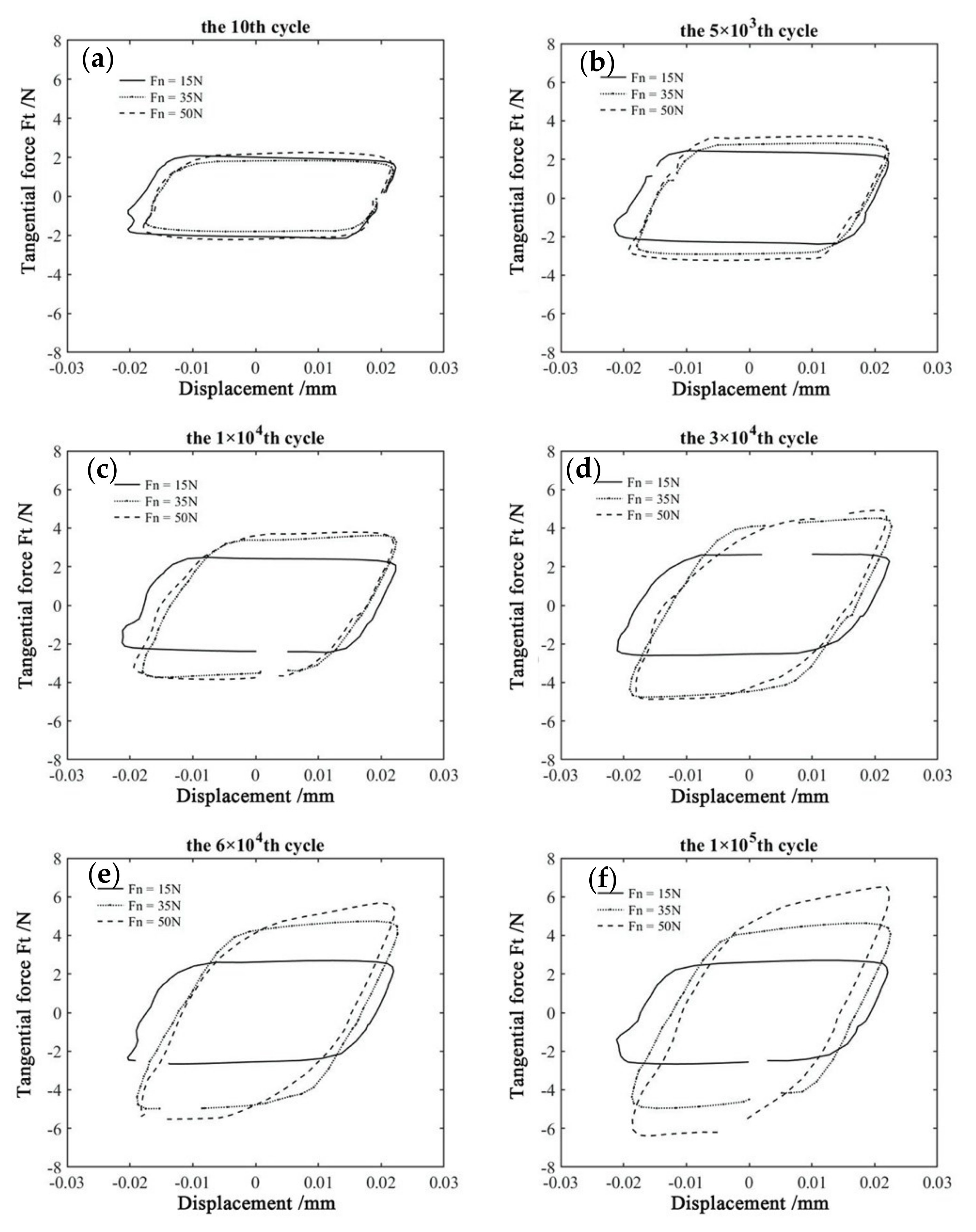
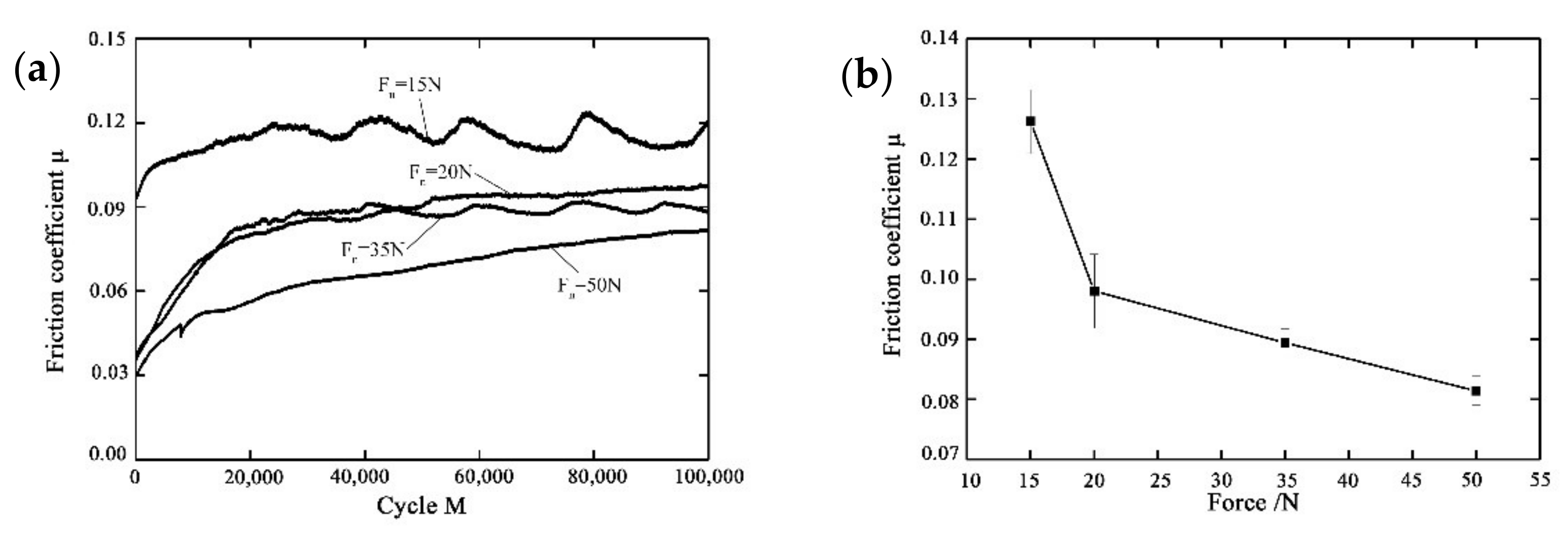
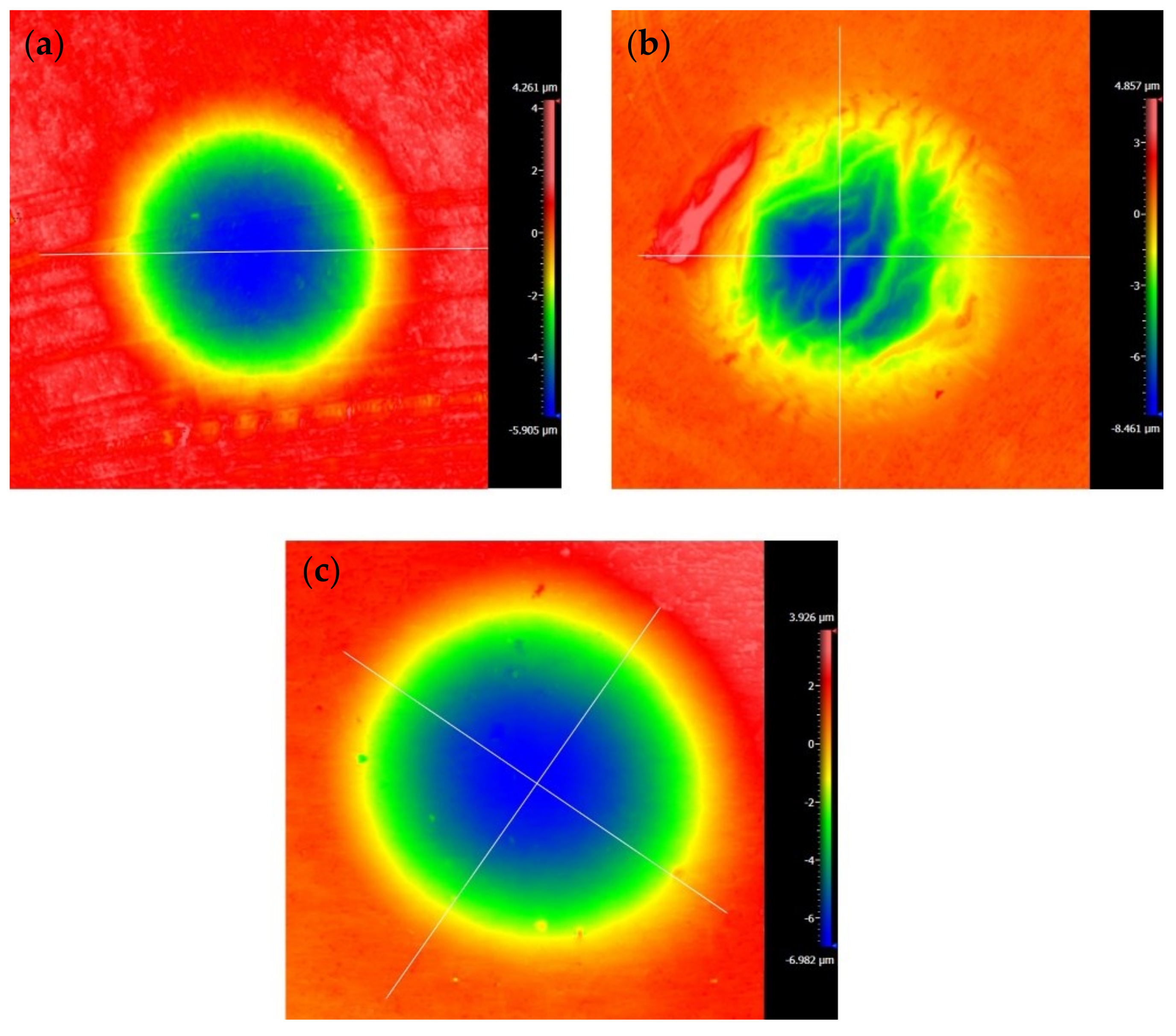
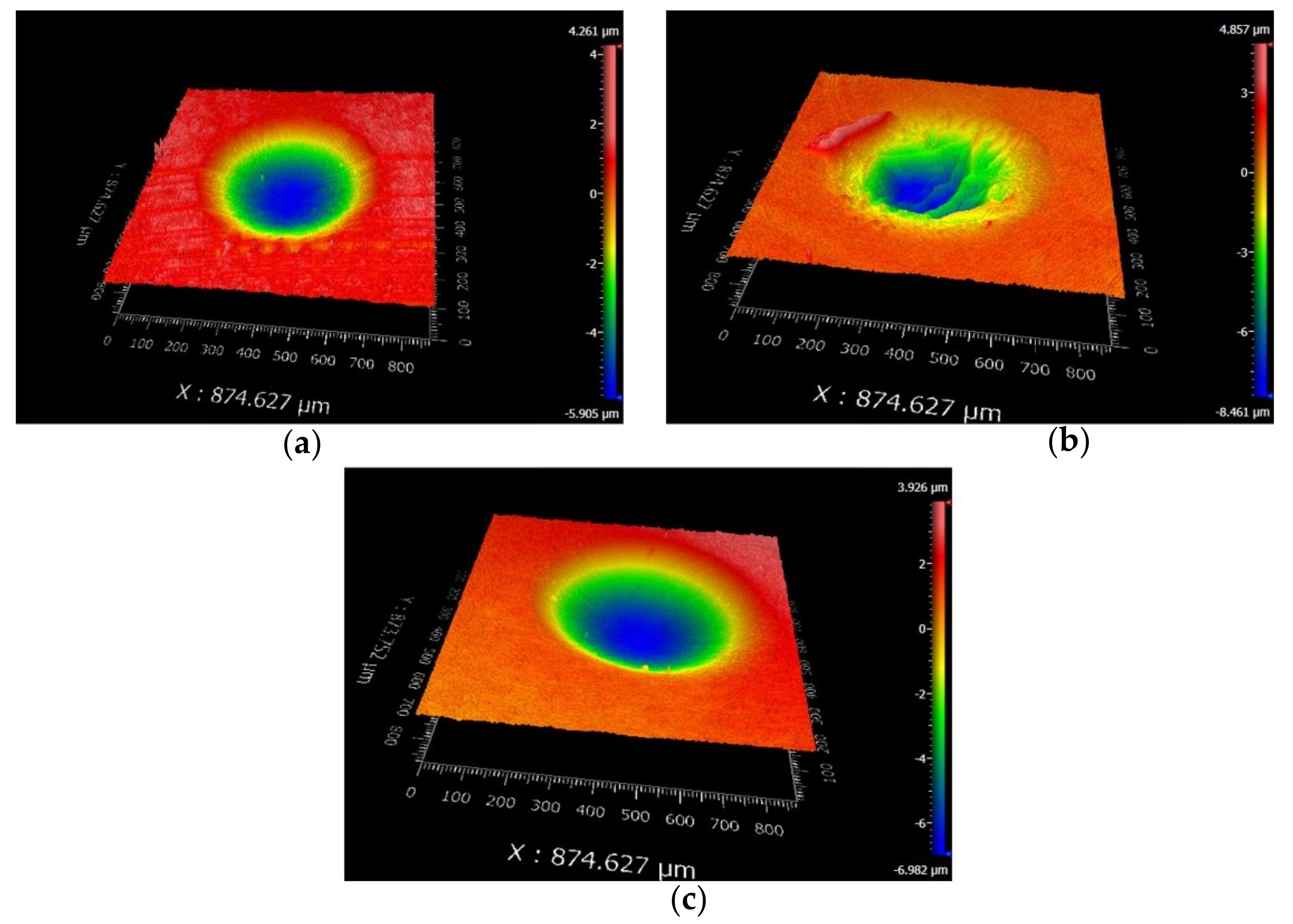
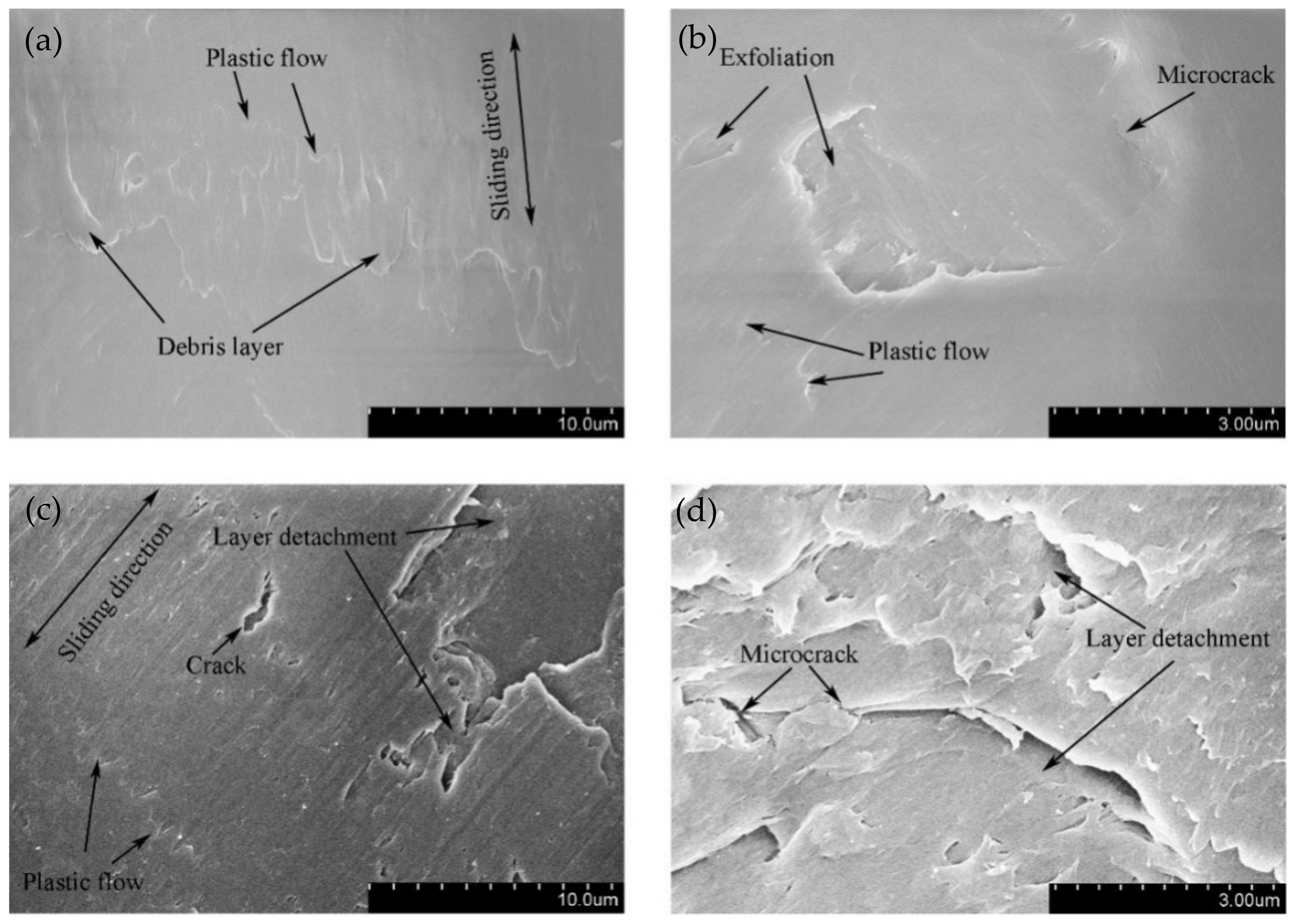
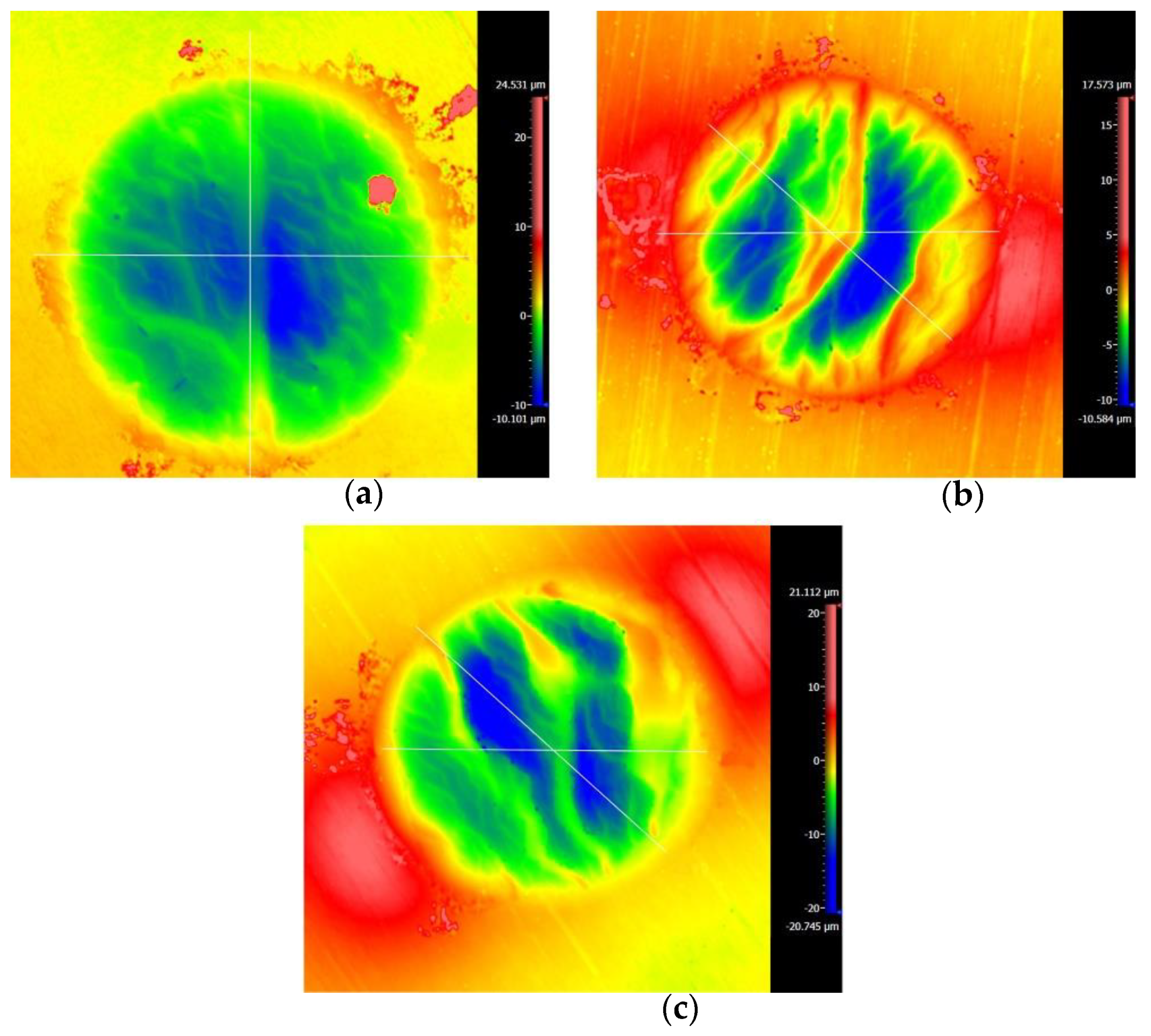
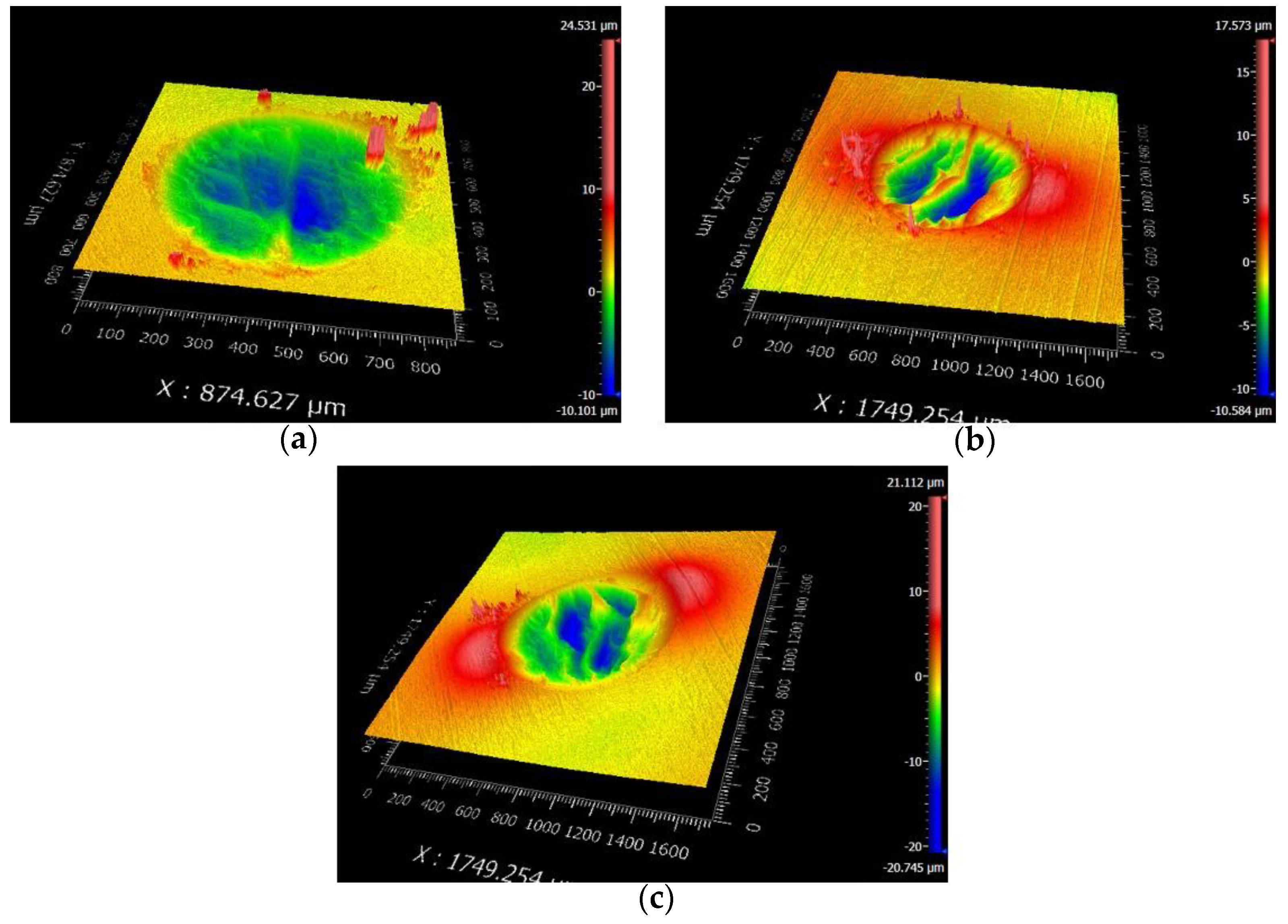
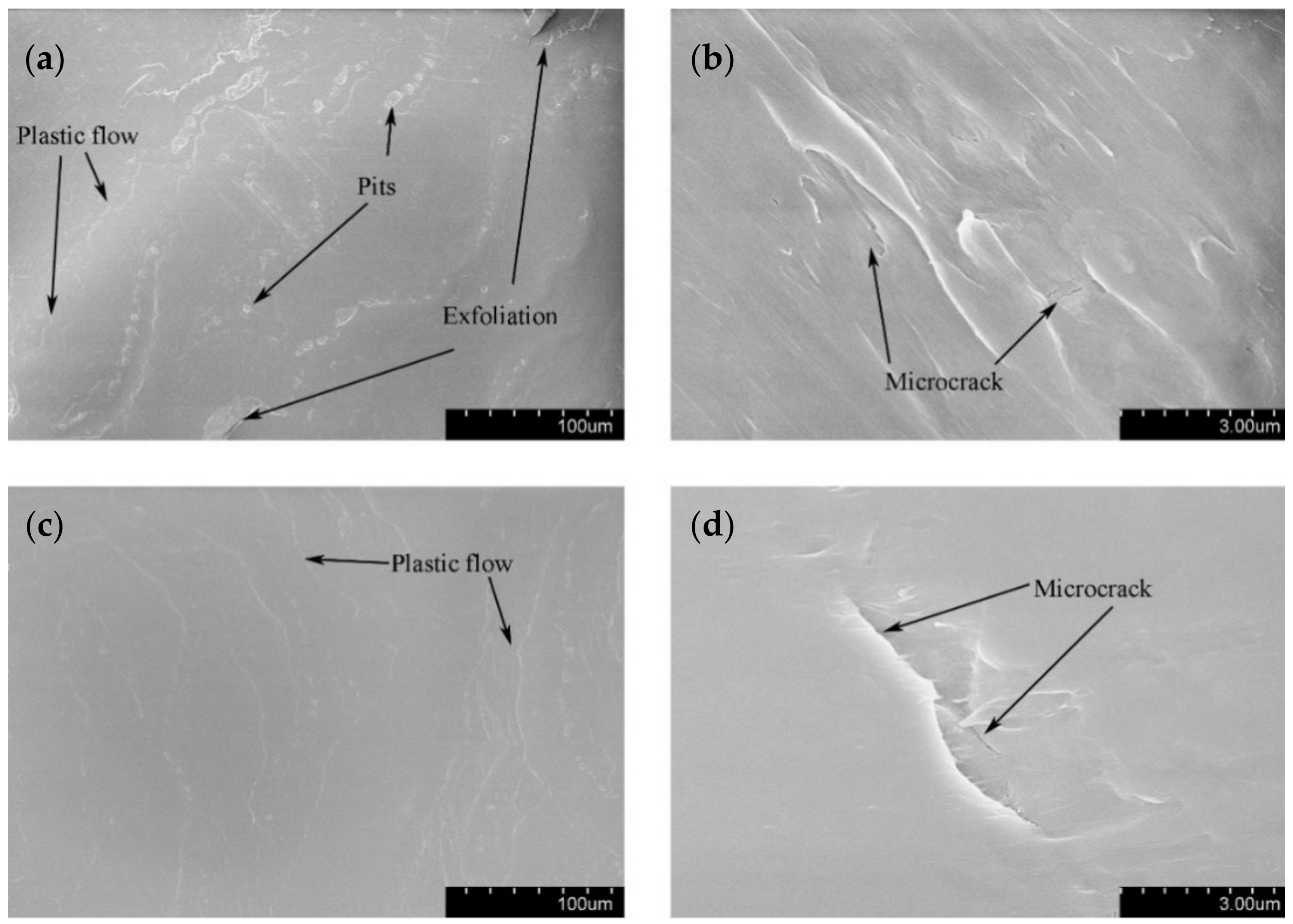
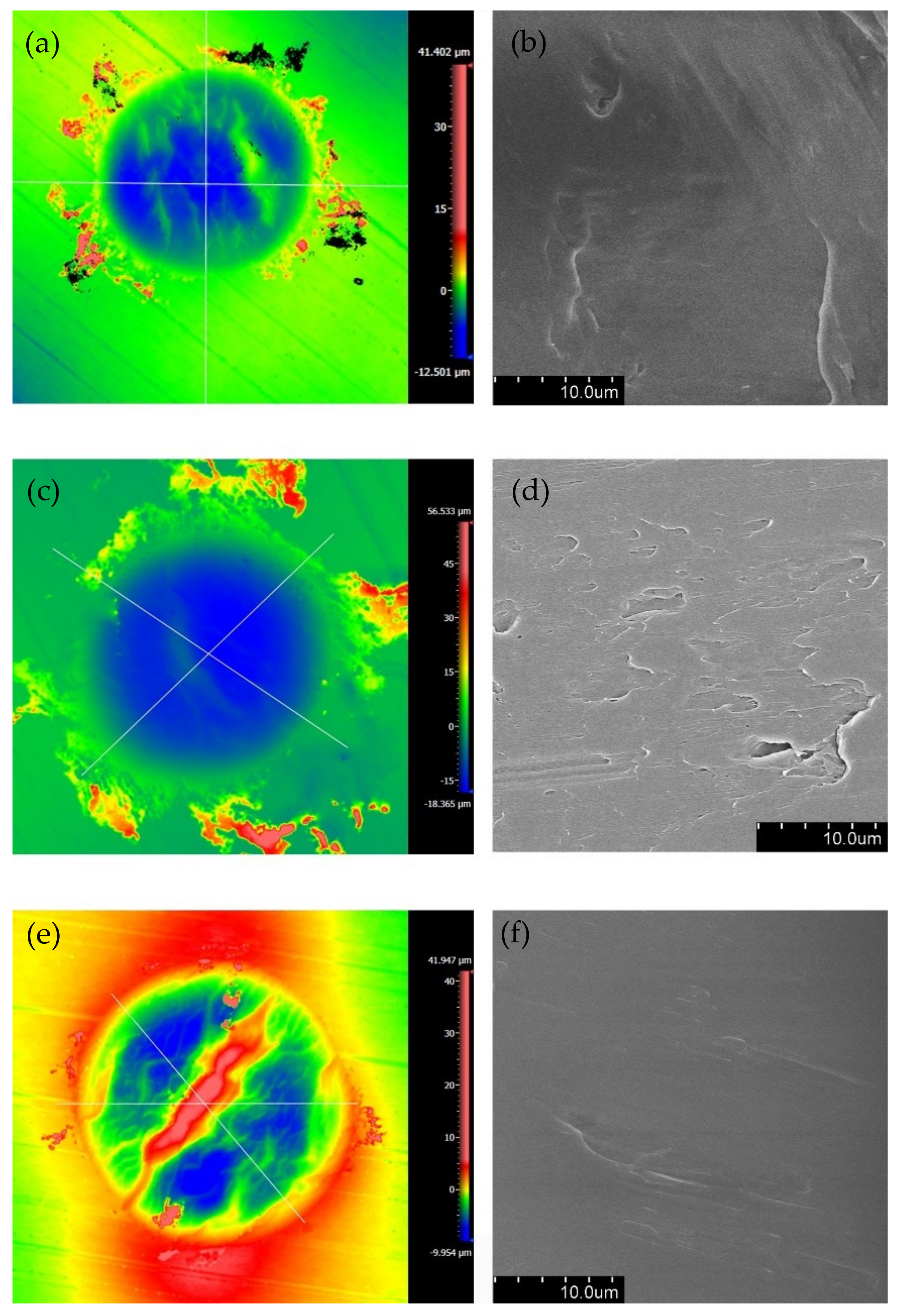
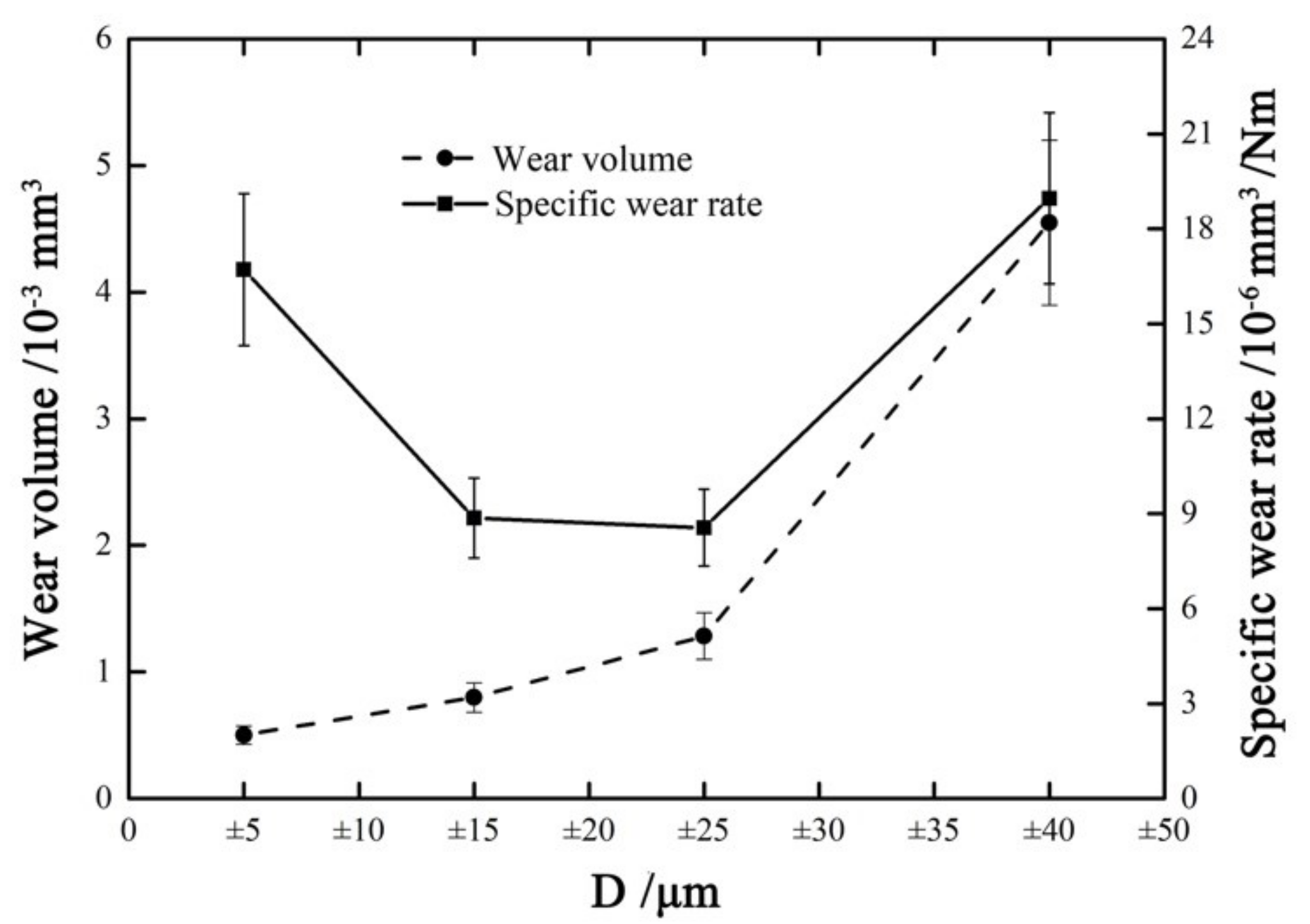
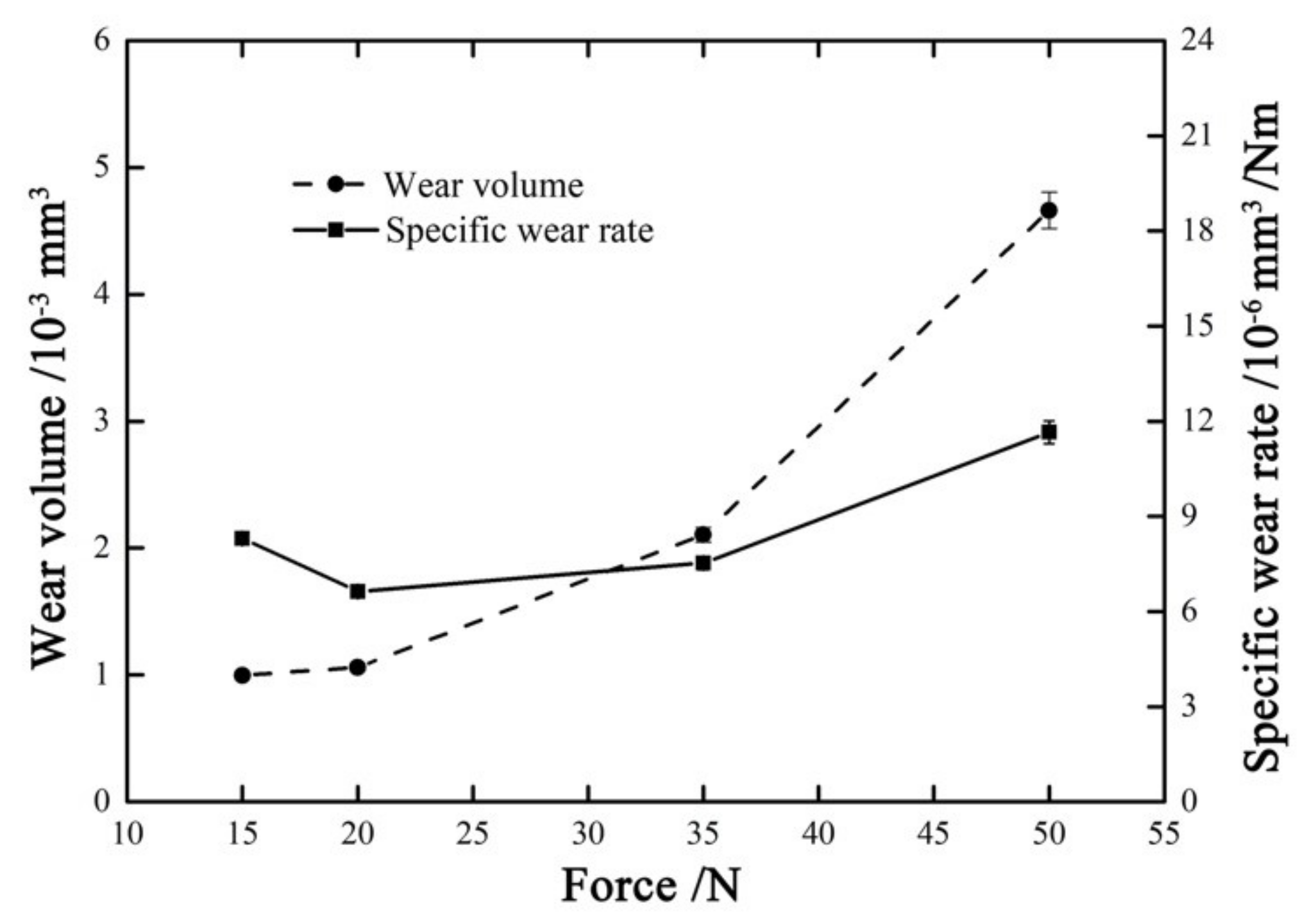

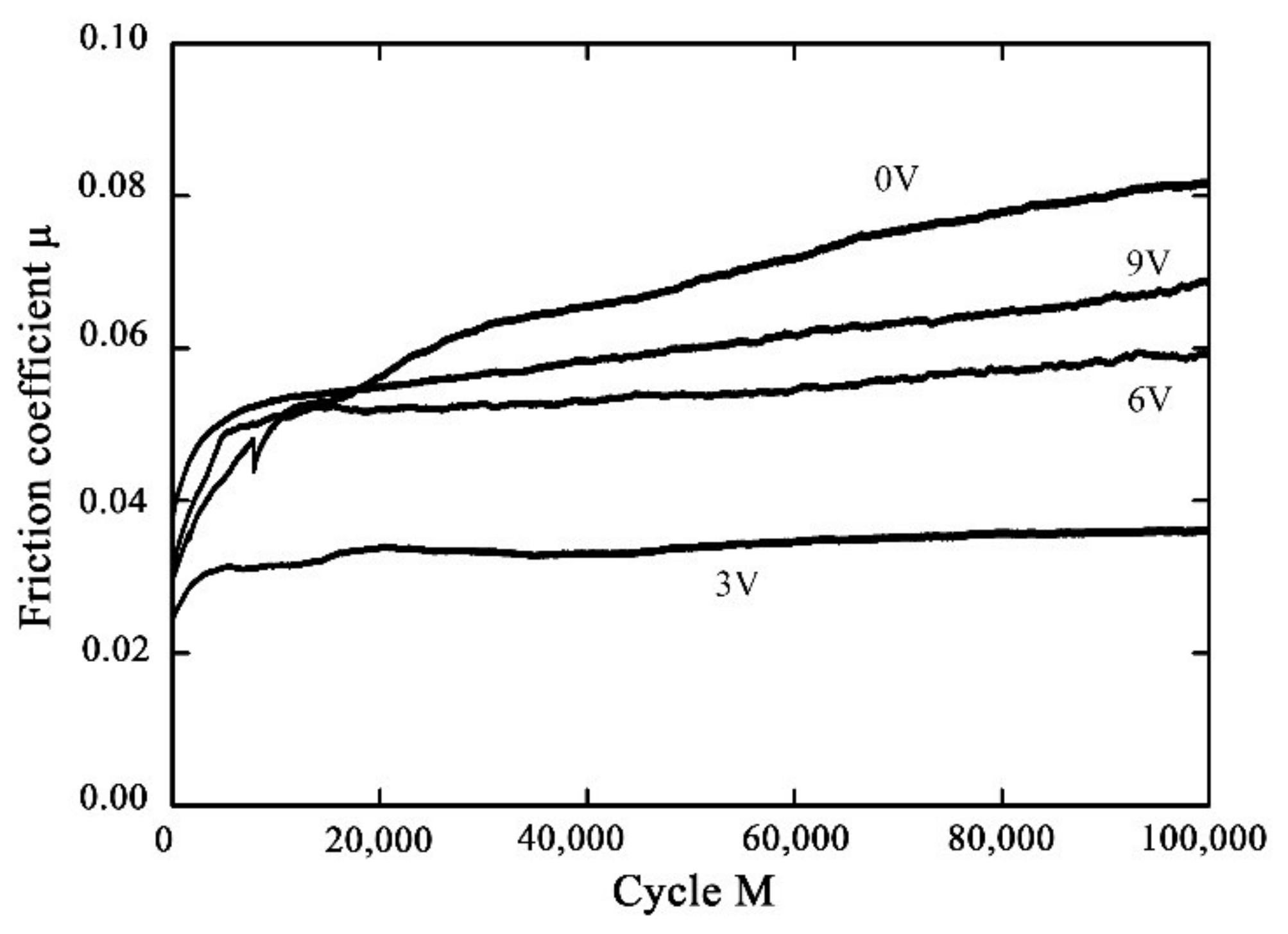
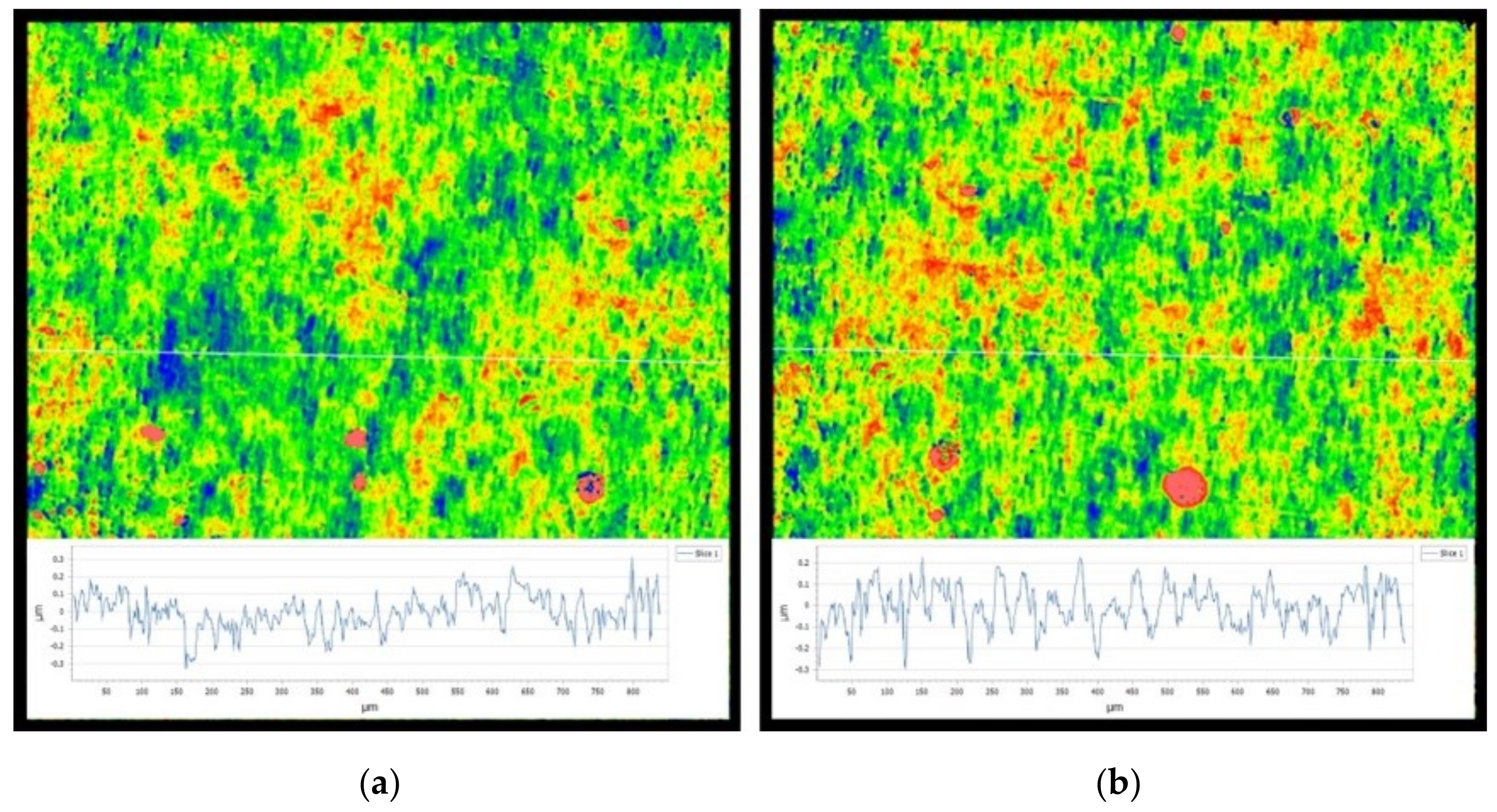
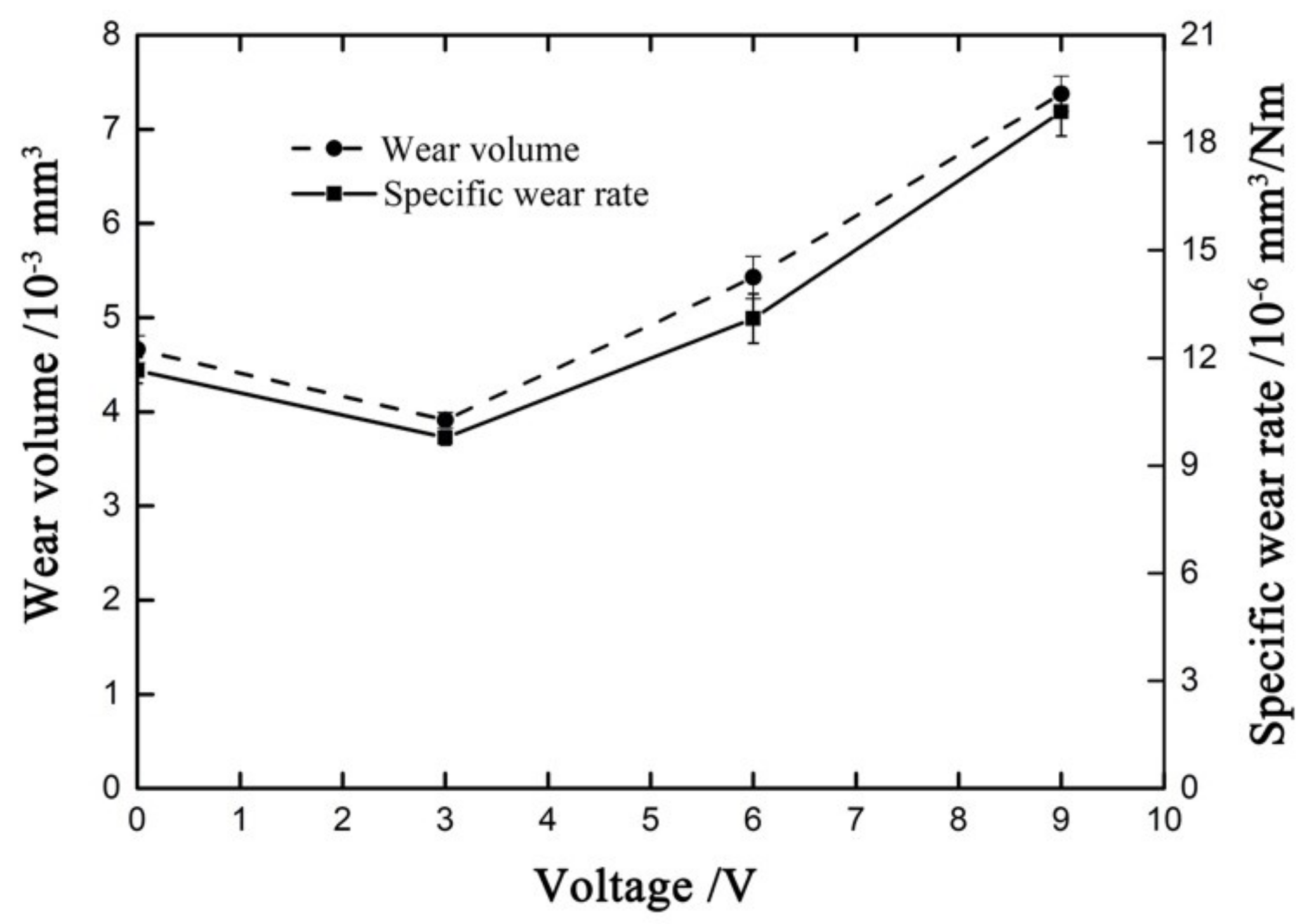
| Properties | Units | Value |
|---|---|---|
| Density, | kg/m3 | 1.78 × 103 |
| Young’s modulus, E | GPa | 1 |
| Poisson’s ratio | - | 0.35 |
| d33 constant | 10−12 C/N | ±21 |
| Yield Strength | 106 N/m2 | 45–55 |
| Tensile Strength at Break | MPa | 35–50 |
| Breaking elongation | - | 20–50% |
| Fretting Region | Damage Type | Possible Causes |
|---|---|---|
| The partial slip region | Abrasive wear, plastic flow | The contact basically conforms to the Mindlin’s elastic contact theory |
| The mixed region | Creeps, wrinkles, plastic deformation, reduced wear rate | The generation of a large plastic zone obtunds the crack growth and enhances the toughness of contact region. |
| The slip region | Layer detachment, crack, wear speeding up | The crack propagation causes micro-defects and material loss. |
Publisher’s Note: MDPI stays neutral with regard to jurisdictional claims in published maps and institutional affiliations. |
© 2021 by the authors. Licensee MDPI, Basel, Switzerland. This article is an open access article distributed under the terms and conditions of the Creative Commons Attribution (CC BY) license (http://creativecommons.org/licenses/by/4.0/).
Share and Cite
Shu, Y.; Ke, L.; Su, J.; Shen, F. Experimental Studies on Fretting Wear Behavior of PVDF Piezoelectric Thin Films. Materials 2021, 14, 734. https://doi.org/10.3390/ma14040734
Shu Y, Ke L, Su J, Shen F. Experimental Studies on Fretting Wear Behavior of PVDF Piezoelectric Thin Films. Materials. 2021; 14(4):734. https://doi.org/10.3390/ma14040734
Chicago/Turabian StyleShu, Yuanjie, Liaoliang Ke, Jie Su, and Fei Shen. 2021. "Experimental Studies on Fretting Wear Behavior of PVDF Piezoelectric Thin Films" Materials 14, no. 4: 734. https://doi.org/10.3390/ma14040734
APA StyleShu, Y., Ke, L., Su, J., & Shen, F. (2021). Experimental Studies on Fretting Wear Behavior of PVDF Piezoelectric Thin Films. Materials, 14(4), 734. https://doi.org/10.3390/ma14040734





